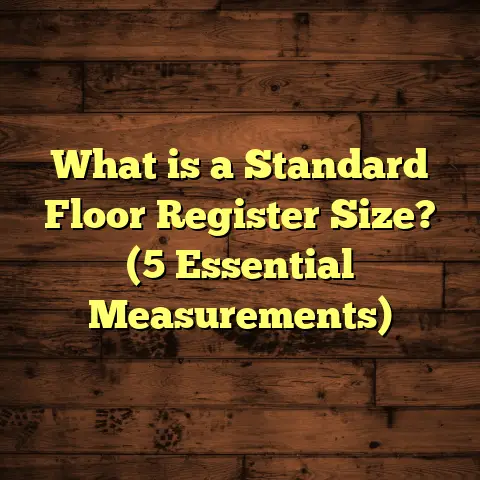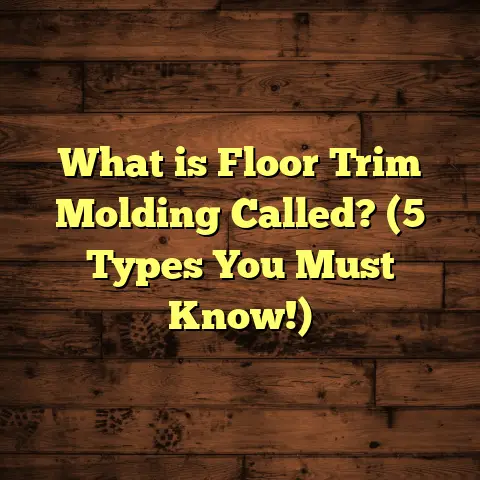What is a Kitchen Floor Reset? (5 Steps for a Stunning Makeover)
Installing a new kitchen floor can be surprisingly straightforward. I’ve found that with the right approach, even someone with basic DIY skills can achieve a major transformation without breaking a sweat. The key lies in understanding what a kitchen floor reset really means and how to tackle it step by step. Curious? Let me walk you through what I’ve learned over the years.
What is a Kitchen Floor Reset?
Simply put, a kitchen floor reset means removing your existing floor covering and installing a fresh, new surface. It’s more than just putting down new tiles or planks; it involves preparing the subfloor properly, fixing any hidden issues, and selecting materials that suit both your lifestyle and kitchen’s demands.
When I first heard the term, I thought it was just about changing flooring. But it’s actually about refreshing the foundation and surface to give your kitchen a stunning makeover that lasts. It’s a balance between demolition, repair, and installation.
At its core, a kitchen floor reset is about bringing life back to what can sometimes be the most overlooked part of your kitchen. The floor is under constant stress—from dropped utensils to spilled liquids and heavy foot traffic. Over time, even the most durable floors show wear and tear. That’s when a reset becomes necessary.
The Importance of Subfloor Preparation
One thing I’ve learned from countless projects is that the success of your new floor largely depends on how well you prepare the subfloor. The subfloor is the layer beneath your visible flooring—often plywood or concrete—and it plays a huge role in supporting whatever surface you choose.
If the subfloor has problems like moisture damage, unevenness, or structural weaknesses, no amount of fancy tile or hardwood will save your floor from early failure.
Is Kitchen Floor Reset Right For You?
You might wonder if you need a full reset or just a simple refresh. A reset usually makes sense if:
- Your current flooring shows significant damage (cracks, warping, discoloration).
- The subfloor has issues that could affect new flooring.
- You want to change the material type entirely (for example, switching from tile to vinyl plank).
- You are preparing your home for sale and want to add value.
- You want to improve comfort and safety underfoot.
If your floor looks good but just needs cleaning or minor repairs, resetting might be overkill. But if you want something fresh that lasts, resetting is often worth the effort.
Step 1: Evaluating Your Existing Floor and Subfloor
Before pulling up anything, I always inspect the current flooring and the subfloor beneath it. You’d be surprised how many kitchens hide old issues under layers of tile or vinyl.
During one job, I discovered a plywood subfloor with water damage that wasn’t visible until I removed the old laminate flooring. Fixing it involved replacing sections and adding a moisture barrier—this took extra time but saved the client from future headaches.
Here’s what you should check:
- Condition of existing floor: Is it loose, cracked, or uneven?
- Subfloor type: Concrete, plywood, or OSB? Each needs different prep.
- Signs of moisture: Stains, mold, or soft spots.
- Leveling: Floors must be flat within 3/16″ over 10 feet for most materials.
Getting this right upfront prevents costly mistakes later.
How to Inspect Your Subfloor
If you’re brave enough to peek underneath your flooring—either by lifting a corner or checking from below (if you have a basement)—look for:
- Water stains or mold.
- Cracked or rotting wood.
- Loose panels or squeaky spots.
- Uneven surfaces or bumps.
I recommend using a flashlight and sometimes a moisture meter if you have access to one. These small tools can save you from guessing.
Personal Experience: Finding Hidden Surprises
One memorable project had me lifting vinyl sheets only to find old linoleum underneath that was glued down with stubborn adhesive. Beneath that was concrete with multiple cracks filled in over the years. It turned out the homeowner didn’t realize their floor had been patched multiple times.
This kind of discovery means more work but also ensures the new floor won’t suffer from past shortcuts.
Step 2: Removing the Old Flooring Carefully
Taking up old flooring can be satisfying but tricky. Some materials like vinyl peel off easily; others like ceramic tile require tools like a chisel or floor scraper.
One challenge I faced was removing glued-down vinyl tiles on an uneven concrete slab. It took hours of scraping and even some chemical adhesive removers to get a clean surface.
A few tips from my experience:
- Use a pry bar or scraper for stubborn materials.
- Wear protective gear—dust and sharp edges can be hazards.
- Dispose of old materials responsibly; some may be recyclable.
Patience here pays off. Rushing can damage the subfloor or injure you.
Tools I Recommend for Removal
For most kitchen floor resets, having these tools makes life much easier:
- Floor scraper or chisel
- Pry bar
- Hammer
- Utility knife
- Knee pads (trust me on this)
- Respirator mask (for dust)
- Adhesive remover (for stubborn glue)
If you’re dealing with tile or stone, renting a power scraper or rotary hammer with chisel attachments can speed things up significantly.
Handling Disposal
Old flooring materials vary in disposal method. Tiles and concrete pieces might go to construction waste facilities. Some vinyl tiles contain asbestos if installed before the 1980s—if unsure, get samples tested before disturbing them.
I’ve always encouraged clients to check with local regulations about disposal to avoid fines.
Step 3: Repairing and Preparing the Subfloor
This step is where many people get stuck. If your subfloor isn’t stable, no new flooring will last.
I always patch holes, sand rough patches, and install leveling compounds where needed. For wooden subfloors, securing loose boards with screws makes a big difference in reducing squeaks later.
In one kitchen reset, applying a self-leveling compound on concrete smoothed out dips that would have ruined the tile installation. The key is to follow product instructions carefully and allow proper drying time.
Think of this as setting the stage for your new floor to shine.
Common Subfloor Issues and Fixes
Here are some typical problems I encounter:
- Soft spots: Usually caused by water damage; often require replacing damaged plywood.
- Uneven surfaces: Use self-leveling compounds or sanding to smooth out dips and bumps.
- Loose panels: Secure them with screws to stop squeaking.
- Moisture: Install vapor barriers or moisture membranes when needed.
Case Study: Fixing Water-Damaged Subfloors
I once worked on a kitchen where the homeowner had ignored water leaks under the sink for years. The plywood was swollen and crumbling in spots. We removed damaged sections and replaced them with marine-grade plywood designed for moisture resistance.
Adding a polyethylene moisture barrier before installing flooring helped protect against future leaks.
How Long Should You Wait Before Installing?
Depending on repairs made—especially when using leveling compounds—drying times vary from 24 hours to several days. Don’t rush this! Installing new flooring on damp subfloors causes warping and adhesive failures later.
Step 4: Choosing Your Flooring Material Wisely
Here’s where decisions get fun—and sometimes overwhelming. Kitchens demand floors that stand up to spills, heat, frequent cleaning, and foot traffic.
From my projects:
- Ceramic or porcelain tile: Durable and water-resistant but cold underfoot.
- Vinyl plank: Affordable, easy to install, and water-friendly.
- Engineered hardwood: Offers warmth but needs moisture precautions.
- Laminate: Budget-friendly but less tolerant of water.
A study I read showed vinyl plank floors had a 30% faster installation time than tile on average. Plus, they scored high on homeowner satisfaction due to comfort and ease of maintenance.
I usually recommend vinyl plank for busy families or those wanting a quick update without heavy construction. Tile works great if you want durability and style but expect longer installation.
How I Help Clients Choose Materials
I ask questions like:
- How much foot traffic does your kitchen get?
- Do you have kids or pets?
- How often do you cook heavy meals that might cause spills?
- What’s your budget?
- What style do you want?
Sometimes clients want hardwood for warmth but forget about moisture issues around sinks and dishwashers. That’s why engineered hardwood with better moisture resistance can be a better choice in kitchens than solid hardwood.
Examples of Flooring Types in Action
Vinyl Plank: One client chose vinyl plank for its waterproof qualities since they spilled drinks regularly with young kids running around. Installation took just two days, and they loved how soft it felt underfoot compared to tile.
Porcelain Tile: Another loved ceramic tile’s sleek look but had us add underfloor heating because they found it cold during winter months. This added comfort made all the difference for them.
Step 5: Installing the New Floor with Care
This is the payoff stage. Proper installation methods ensure your new floor looks professional and lasts long.
From my hands-on experience:
- Follow manufacturer guidelines closely.
- Leave expansion gaps for wood or laminate floors.
- Use quality underlayment for moisture control and sound absorption.
- Take your time cutting pieces precisely; sloppy cuts show immediately.
I remember installing click-lock vinyl planks in less than two days for a client who wanted minimal disruption. The key was prepping everything well beforehand so installation was smooth and fast.
DIY vs Professional Installation
I often get asked whether people should install their own floors or hire pros. Here’s my take:
- DIY is great if you’re handy, patient, and have time.
- Professional installers bring experience that reduces mistakes.
- Some materials (like tile) require specialized skills for cutting and grouting.
- Consider warranties; some require professional installation.
In my experience, clients who hire pros get better long-term results but pay more upfront. It depends on your situation.
Common Installation Challenges
Even pros face issues like:
- Uneven subfloors causing gaps.
- Misaligned tiles or planks.
- Problems with adhesive curing.
- Expansion gaps being too small or large.
Taking time during installation helps avoid these problems.
Successes and Challenges I’ve Seen
Every project has its wins and hurdles. One kitchen floor reset I did involved removing decades-old linoleum over concrete. The old adhesive made prep tough, but switching to a special primer fixed adhesion problems for the new tile.
Another time, moisture issues forced me to replace an entire subfloor—a costly surprise for the homeowner but critical to avoid damage down the line.
On the flip side, I’ve had clients thrilled with how quickly their floors transformed their kitchens—some even reported increased home value after resetting their floors.
Story: From Disaster to Dream Floor
A client once called me after their DIY attempt left their laminate bubbling due to trapped moisture. We had to remove everything again and start fresh with proper moisture barriers and ventilation improvements before installing new vinyl planks. It was frustrating but rewarding once finished—the kitchen looked brand new!
Why Patience Pays Off
Rushing through steps leads to shortcuts that cause problems later—like cracked tiles or warped boards. I always remind clients: investing time in prep means fewer headaches down the road.
Some Numbers That Might Interest You
- Average kitchen floor reset costs range from $4 to $12 per square foot depending on materials.
- Vinyl plank installation averages around $3-$5 per square foot labor cost.
- Tile labor costs tend to be higher at $7-$15 per square foot due to prep and grout work.
- Proper subfloor prep can add 10-20% more time but reduces risk of early failure by over 50%.
Knowing this helps set realistic expectations on budget and timeline.
Budgeting Tips
Plan for extra costs like:
- Subfloor repairs ($1-$3 per sq ft)
- Removal fees ($0.50-$2 per sq ft)
- Waste disposal
- Underlayment ($0.25-$1 per sq ft)
Using online tools like FloorTally can help estimate costs based on local labor rates and materials—something I use regularly when advising clients.
Maintenance Tips Post Reset
A kitchen floor reset isn’t just about installation; keeping your new floor looking great takes care too.
Here are simple tips from my experience:
- Clean spills immediately to prevent stains.
- Use gentle cleaning products recommended for your material.
- Avoid harsh chemicals that damage finishes.
- Place mats near sinks to catch water drips.
- Refinish hardwood floors every few years when needed.
One client told me how their easy-to-clean vinyl plank stood up to their two energetic dogs better than previous carpet ever did.
Final Thoughts: Is This Project Worth It?
Resetting your kitchen floor can feel like a big project—but it’s one of those upgrades that makes everyday life better. Your kitchen is where memories happen—from cooking family meals to casual chats over coffee—and having a floor that looks good and performs well matters more than you’d think.
If you’re considering a reset, take time with each step—from evaluation through installation—to avoid surprises later on. Whether you do it yourself or hire experts, planning is everything here.
If you want tips on picking materials or handling tricky installs, just ask—I’m here to help you get that stunning kitchen floor makeover done right!





